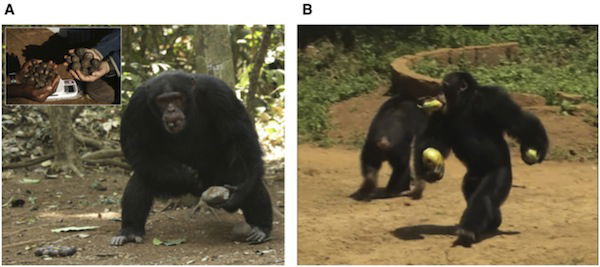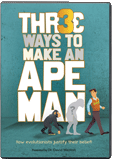
Walking Up the Evolutionary Tree
Are we human because we learned to walk on our own two feet . . . or do we walk upright because we’re human?
News Source
Since fossils are notoriously reluctant to walk, “the earliest evidence of habitual bipedality”1 eludes evolutionists. But because they assume humans and chimpanzees share a common ape-like ancestor, an international team of researchers, who just published studies of chimpanzee behavior in Current Biology, believe they have discovered “the selective advantage that led to the origin of hominin bipedality.”2
“Bipedality as the key human adaptation may be an evolutionary product of persisting competitive strategies that ultimately set our ancestors on a separate evolutionary path,”3 they write. Believing natural selection is the driving force that propelled ape-like ancestors up the evolutionary tree of life, the team wished to determine what survival advantage bipedality could bequeath. So they gave eleven chimps a small supply of coula nuts—a chimp favorite—and watched the show . . . for 44.5 hours.
The chimps were so eager to scarf up coula nuts they walked upright in intermittent bursts three times more often than when coula nuts abounded. “Presence of coula nuts also stimulated more varied forms of carrying: chimpanzees used not only their hands,” they report, “but also mouths and feet to transport items and frequently employed more than one body part at a time, thereby increasing the number of items that could be carried simultaneously.”4

Apes are able to walk upright only with an inefficient leg-swinging gait and ordinarily do so only for relatively short distances. Their pelvic anatomy will not permit them to habitually walk in a genuine and truly efficient bipedal gait. So why would an ape choose to go to the extra effort to walk upright when he is perfectly designed to comfortably and enjoyably walk on all fours? These chimpanzees were subjects in a study that provided incentive for this behavior: favorite food. In photo A, a chimp is carrying stones for crushing nuts in his left hand and foot. He has coula nuts stuffed in his mouth and in his right hand. (The inset shows nuts provided to tempt the ape up onto two feet.) Photo B shows a chimp making off with three papayas using all his resources: both hands and mouth to carry, leaving only two feet for his escape. Image from Current Biology.5
In a companion study, chimps were observed raiding crops. The most ambitious thieves—the ones carrying the most contraband—resorted to bouts of bipedality, using their hands and mouths to carry more.
“These chimpanzees provide a model of the ecological conditions under which our earliest ancestors might have begun walking on two legs,” explains anthropologist Brian Richmond. “Something as simple as carrying—an activity we engage in every day—may have, under the right conditions, led to upright walking and set our ancestors on a path apart from other apes that ultimately led to the origin of our kind.” The somewhat Lamarckian idea here is that ape-like ancestors best able to walk upright could carry away more food during tough times, survive and reproduce, and eventually through natural selection produce a bipedal anatomy. In other words, “Over time, intense bursts of bipedal activity may have led to anatomical changes.”
Based on the researchers’ logic, since eager chimps used their mouths and even feet to carry extra nuts, we might well ask why humans didn’t evolve cheek pouches like hamsters and toes designed to grip-on-the-go. Furthermore, exercising a physical skill feasible within the anatomical constraints of a creature’s design does not demonstrate it is ancestrally related to another kind of creature.
Exercising a physical skill feasible within the anatomical constraints of a creature’s design does not demonstrate it is ancestrally related to another kind of creature.
These researchers admit the impossibility of determining the origin of bipedality “from the fossil or archaeological records.”6 Yet they believe they can determine the evolution of bipedal anatomy and a resulting transformation to human-ness by observing counterfeits of bipedality in living animals not anatomically equipped for true bipedality. Humans are anatomically designed for bipedal walking. The angles of the leg and thigh bones at the knee, the structure of the feet, the shape of the pelvis, and arrangement of the muscles all contribute to an integrated design allowing humans to walk upright without the exaggerated side-to-side swing an ape must use to walk on two feet. Having a better ape-walk would not produce this constellation of anatomical changes.
But the real point—aside from the fact there is no evidence that humans and apes share an ape-like ancestor anyway—is that the study implies we became human because we learned how to walk. Biblically we know that God created animals (including apes) and humans as separate creations on the 6th day of Creation week. Humans were made in the image of God with unique mental and spiritual attributes. And while our Common Designer gave us certain similar physical features, He also created apes and humans with many distinct differences. Nothing in the fossil record or genetics confirms humans evolved from ape-like ancestors. Neither does this study tell us anything about how human ancestors learned to walk. Humanity’s ancestors were Adam and Eve. And God created Adam and Eve fully able to walk on their own two feet.
Further Reading
- Evaluating the Gait Analysis of Ardi
- Did Humans Really Evolve from Apelike Creatures?
- Scientists Admit Genetic Data Timing Uncertain
For More Information: Get Answers
Remember, if you see a news story that might merit some attention, let us know about it! (Note: if the story originates from the Associated Press, FOX News, MSNBC, the New York Times, or another major national media outlet, we will most likely have already heard about it.) And thanks to all of our readers who have submitted great news tips to us. If you didn’t catch all the latest News to Know, why not take a look to see what you’ve missed?
(Please note that links will take you directly to the source. Answers in Genesis is not responsible for content on the websites to which we refer. For more information, please see our Privacy Policy.)
Footnotes
- Susana Carvalho et al., “Chimpanzee Carrying Behaviour and the Origins of Human Bipedality,” Current Biology 22, no. 6 (March 20, 2012): 180–181, doi:10.1016/j.cub.2012.01.052.
- Ibid.
- Ibid.
- Ibid.
- Ibid.
- Ibid.
Recommended Resources

Answers in Genesis is an apologetics ministry, dedicated to helping Christians defend their faith and proclaim the good news of Jesus Christ.
- Customer Service 800.778.3390
- © 2024 Answers in Genesis







